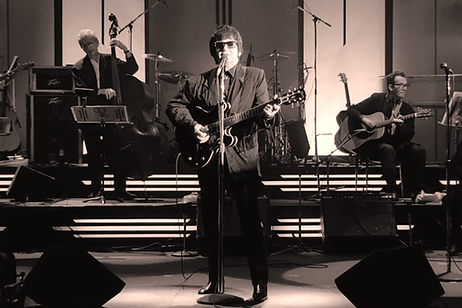
good music

Roy Kelton Orbison was born on April 23, 1936, at 3:30 PM in Vernon, Texas, to Nadine, a nurse, and Orbie Lee, a worker. The second of their children, Roy grew up surrounded by music. For his sixth birthday, he requested a harmonica, but his father gifted him a guitar, sparking a lifelong passion. Orbie Lee, along with his brother Charlie and Nadine’s brother Kenneth Schultz, taught Roy to play. Alongside Clois Russell, a neighbor and colleague of Orbie Lee, they often played and sang together, with Roy’s first song being “You Are My Sunshine.” His quick learning allowed him to stay up late, performing with the adults. In 1942, the Orbison family moved to Fort Worth, where Roy’s parents worked in munitions and aircraft factories during World War II. In 1944, due to a polio epidemic, Roy and his older brother Grady were sent to live with their maternal grandmother in Vernon, where Roy wrote his first song, “A Vow of Love.” In 1945, he won a contest on KVWC radio in Vernon, earning his own weekly show. The following year, he tied for first place in a talent contest at a medicine show, singing “Mountain Dew” and “Jole Blon,” splitting a $15 prize. The family reunited in Vernon after the war and moved to Wink, Texas, in late 1946. At 13, Roy formed his first band, The Wink Westerners, in 1949. By 1951, they performed regularly on KERB radio in Kermit, securing a weekly show by 1953. The band played a mix of country, big-band standards, and pop, including songs like “Kaw-liga” and “In the Mood.” Roy also worked summer jobs, from tar shoveling to oil field labor, and was involved in Wink High School’s marching band, singing octet, and managed the Kittens football team in 1952. The Wink Westerners began earning paid gigs, including a tour with R.A. Lipscomb for the Lions Club in 1953, performing at the 36th International Lions Club Convention in Chicago. Roy graduated from Wink High in 1954 and briefly attended North Texas State College in Denton. In 1955, he recorded “Ooby Dooby” with college friends Wade Lee Moore and Dick Penner at Jim Beck’s studio in Dallas. Though Columbia Records passed, the band, now called The Teen Kings, signed with Je-Wel Records and recorded “Ooby Dooby” again in 1956 at Norman Petty Studio in Clovis, New Mexico. This caught the attention of Sam Phillips at Sun Records, leading to a contract. “Ooby Dooby” peaked at #59 in June 1956, but subsequent Sun singles didn’t chart. The Teen Kings split in December 1956, and Roy stayed with Sun until 1958, honing his songwriting. In 1958, Roy wrote “Claudette” for The Everly Brothers, which reached #30 as the B-side to “All I Have To Do Is Dream.” Signed by Wesley Rose to Acuff-Rose Music Publishing, he briefly worked with RCA Victor before joining Monument Records in 1959. His first Monument single, “Uptown,” performed modestly, but “Only the Lonely” in 1960 soared to #2 in the U.S. and #1 in the UK, showcasing his unique voice and innovative style. Hits like “Running Scared” (#1), “Crying,” “Dream Baby,” and “In Dreams” followed, establishing Roy as a global star. His 1963 UK tour with The Beatles sold out instantly, with Roy performing 14 encores on the first night. “Oh Pretty Woman,” co-written with Bill Dees in 1964, became his biggest hit, selling about seven million copies and topping charts worldwide. Roy toured with The Beach Boys and The Rolling Stones, but his move to MGM in 1965 marked a decline. Personal tragedies struck: his wife Claudette died in a 1966 motorcycle accident, and two of his three sons perished in a 1968 house fire. Roy married Barbara Anne Marie Wilhonnen Jacobs in 1969, and they built a new home in Hendersonville, Tennessee. His MGM contract ended in 1973, followed by a brief stint with Mercury Records in 1974. He returned to Monument in 1976, but health issues, including open-heart surgery in 1978, slowed his output.
The 1980s brought a resurgence. Collaborations like “That Lovin’ You Feelin’ Again” with Emmylou Harris (Grammy, 1980), “Wild Hearts Run out of Time” in Insignificance (1985), and “In Dreams” in Blue Velvet (1986) revitalized his career. In 1987, Roy was inducted into the Rock and Roll Hall of Fame, with Bruce Springsteen praising his influence. He signed with Virgin Records, re-releasing hits and recording new material with Jeff Lynne. The TV special Roy Orbison and Friends: A Black and White Night (1988), featuring Springsteen, Elvis Costello, and others, became iconic. Roy joined The Traveling Wilburys with George Harrison, Jeff Lynne, Tom Petty, and Bob Dylan, releasing a chart-topping album in 1988. Roy’s final performance was in Highland Heights, Ohio, on December 4, 1988. He died of a heart attack on December 6, 1988, at age 52. His posthumous album, Mystery Girl (1989), became his best-selling record, with “You Got It” reaching the U.S. Top 10. King of Hearts (1992) and The Very Best of Roy Orbison (1996) followed, cementing his legacy. As of 2025, Roy’s estate, managed by his sons Alex, Wesley and Roy Kelton Orbison Jr. through Orbison Records, continues to release archival material.

